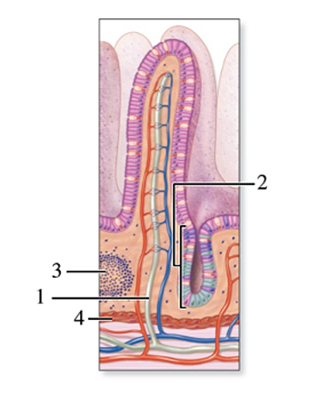A) Soft palate
B) Glossopalatine arch
C) Hard palate
D) Pharyngopalatine arch
E) Labial frenulum
Correct Answer

verified
Correct Answer
verified
True/False
The small intestine is so named because it is shorter than the large intestine.
Correct Answer

verified
Correct Answer
verified
Multiple Choice
Protein digestion begins in the ________; fat digestion begins in the ________.
A) stomach; small intestine
B) mouth; stomach
C) esophagus; stomach
D) small intestine; small intestine
E) small intestine; large intestine
Correct Answer

verified
Correct Answer
verified
True/False
The inferior mesenteric artery and inferior mesenteric plexus supply the same structures.
Correct Answer

verified
Correct Answer
verified
Multiple Choice
The gastrocolic reflex
A) generally occurs two or three times per day.
B) propels fecal material toward the rectum.
C) usually occurs during or immediately after a meal.
D) involves mass movements generated by the teniae coli.
E) All of the choices are correct.
Correct Answer

verified
Correct Answer
verified
Short Answer
The _____________ is the region of the oral cavity between the gums and the cheeks or lips.
Correct Answer

verified
Correct Answer
verified
Multiple Choice
Which peritoneal fold supports the large intestine?
A) Greater omentum
B) Lesser omentum
C) Falciform ligament
D) Mesocolon
E) Peritoneal ligament
Correct Answer

verified
Correct Answer
verified
True/False
The cystic duct and common bile duct unite to form the common hepatic duct.
Correct Answer

verified
Correct Answer
verified
Multiple Choice
What type of epithelium lines the majority of the oral cavity?
A) Keratinized stratified squamous
B) Nonkeratinized stratified squamous
C) Pseudostratified ciliated columnar
D) Keratinized stratified cuboidal
E) Nonkeratinized stratified cuboidal
Correct Answer

verified
Correct Answer
verified
Multiple Choice
 -This figure shows an intestinal villus.What specific layer does number 4 indicate?
-This figure shows an intestinal villus.What specific layer does number 4 indicate?
A) Circular layer of muscularis
B) Longitudinal layer of muscularis
C) Lamina propria
D) Basement membrane
E) Muscularis mucosae
Correct Answer

verified
Correct Answer
verified
Short Answer
The partially digested pasty liquid that moves from the stomach to the small intestine is called ______________.
Correct Answer

verified
Correct Answer
verified
Multiple Choice
Which salivary gland empties into the oral vestibule at the level of the second upper molar?
A) Parotid
B) Maxillary
C) Submandibular
D) Sublingual
E) Palatine
Correct Answer

verified
Correct Answer
verified
Multiple Choice
 -This figure shows an intestinal villus.The structure indicated by number 1 is a(n)
-This figure shows an intestinal villus.The structure indicated by number 1 is a(n)
A) intestinal artery.
B) lacteal.
C) microvillus.
D) intestinal vein.
E) flagellum.
Correct Answer

verified
Correct Answer
verified
Multiple Choice
Digestion of carbohydrates begins in the
A) stomach.
B) small intestine.
C) oral cavity.
D) large intestine.
E) liver.
Correct Answer

verified
Correct Answer
verified
True/False
Like the small intestine,the large intestine contains intestinal glands and villi.
Correct Answer

verified
Correct Answer
verified
Multiple Choice
 -This figure shows an intestinal villus.What is the structure indicated by number 3?
-This figure shows an intestinal villus.What is the structure indicated by number 3?
A) Submucosal gland
B) Brunner gland
C) Lymphatic nodule
D) Plicae circulares
E) Mucous gland
Correct Answer

verified
Correct Answer
verified
Multiple Choice
The left colic flexure of the large intestine occurs between the
A) ascending colon and transverse colon.
B) transverse colon and descending colon.
C) descending colon and sigmoid colon.
D) sigmoid colon and rectum.
E) cecum and ascending colon.
Correct Answer

verified
Correct Answer
verified
Multiple Choice
Which statement about teeth is not correct?
A) There are 32 permanent teeth.
B) Two sets of teeth develop during an individual's lifetime.
C) The premolars and molars have dental cusps for crushing and grinding.
D) There are four pairs of incisors,used for cutting and slicing.
E) The canines are cone-shaped,and each has two roots.
Correct Answer

verified
Correct Answer
verified
Multiple Choice
During mastication,the tongue is limited in its movement by its attachment to the
A) hard palate.
B) uvula.
C) lingual frenulum.
D) fauces.
E) soft palate.
Correct Answer

verified
Correct Answer
verified
Multiple Choice
Which is not considered to be an accessory digestive organ?
A) Pancreas
B) Tongue
C) Salivary gland
D) Gall bladder
E) Appendix
Correct Answer

verified
Correct Answer
verified
Showing 21 - 40 of 103
Related Exams